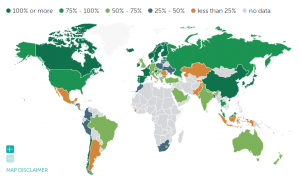
Indian corporates are defying odds by increasing capital expenditure amid a global economic downturn, driven by the optimism from a rebounding economy and increasing demand. This has led to record Rs 36.63 trillion corporate debt in FY23, a 12.6% increase from the previous year. Analytics firm Crisil expects India Inc’s capex to grow 12-14% to Rs 6 trillion in FY24, reflecting a focus on capacity expansion.
Capital expenditures, or capex, represent funds deployed by companies to acquire, upgrade, and maintain physical assets, serving as a strategic move to enhance operational scope and future economic benefits. Chief Economic Advisor V Anantha Nageswaran supports this confidence in expansion, citing data on steel and cement production, and highlights the private sector’s capital expenditure as a crucial contributor to future growth.
READ | Fake GST invoices expose loopholes in indirect tax regime
Corporate debt levels vary significantly from industry to industry with telecommunications and manufacturing firms tend to have high levels of debt. High levels of corporate debt could be a financial risk, while it can also be seen as the sign of a growing economy. When companies are investing heavily in their businesses, it is a sign that they are confident about the future.
Indian corporates’ resilience and increased capex instil faith in the prospects of the Indian economy, indicating positive business sentiment amidst global adversity. Moreover, the rise in capex contributes to national income with a multiplying effect, resulting from the injection of additional money into the economy.
Data from a sample of 406 companies from the BSE 500 reveals that combined debt in FY22 amounted to Rs 32.53 trillion, with interest costs at Rs 2.10 trillion, excluding banks, finance, and insurance firms.
Corporate debt as % of GDP

The confidence of Indian corporates stems from the economy’s resilience in the face of global challenges, supported by various indicators that position India favourably compared to other economies. Notably, higher net direct tax collections and increased advance tax inflows indicate heightened economic activity, positioning India as a rare bright spot amidst the potential recession faced by major global economies. With a GDP growth rate of 7.2% in FY2022-23, India remains the fastest-growing major economy, outperforming most G20 nations in recent years.
Corporates now perceive India is in a period of confidence, marked by accelerated demand drivers and increased economic activity. The rising debt reflects a strong commitment to future preparedness, driven by the expectation of increased demand and order inflows soon.
While rising debts can be profitable, financial services firms emphasise the importance of maintaining healthy balance sheets to avoid potential risks associated with debt levels. Adequate cash flow generation and effective debt management are critical for companies to meet their obligations in the long term.
Currently, companies boast lean balance sheets and robust cash flow generation, with no concerns about asset quality, particularly on the corporate side. This healthy deleveraging sets the stage for a gradual return of leverage to specific sectors.
Mukesh Ambani-led Reliance Industries has the highest gross debt among Indian corporations. RIL has gross debt of Rs 3.35 trillion, an 18.9% increase from FY23. Telecom operators Vodafone Idea and Bharti Airtel follow RIL closely, with debts of Rs 2.38 trillion and Rs 2.26 trillion, respectively. Other notable firms include NTPC, Indian Oil Corporation, ONGC, and Tata Motors, among others, featuring in the top 10 debt-ridden companies.
Toyota Motor Corporation has the highest gross debt in the world at $200 billion. AT&T is the second-highest with a gross debt of $182 billion. Verizon Communications ($174 billion), Deutsche Telekom ($153 billion) and Mercedes-Benz Group ($109 billion) are the other companies with high debt levels.
Heavily indebted companies face risk of default as interest rates remain at elevated levels across the world. This is true even for resilient economies like India that are growing at a fast pace. Emerging market economies such as China and India have greater concentrations of corporate debt. Cash buffers built up by companies offer temporary relief against rising interest rates. Despite this, high levels of short-term debt can put severe pressures on companies.

